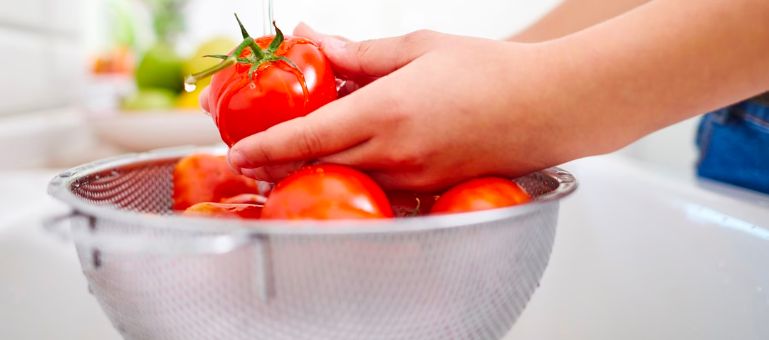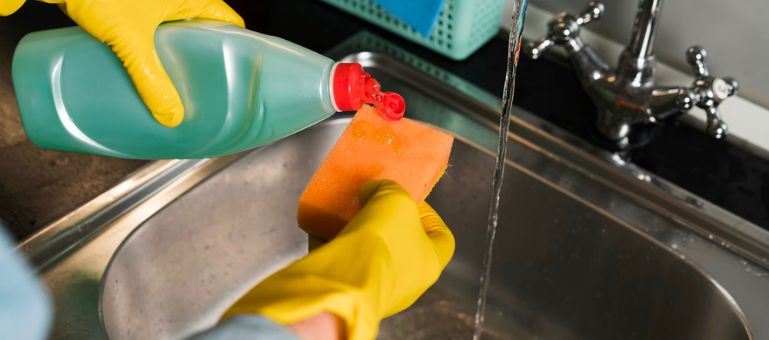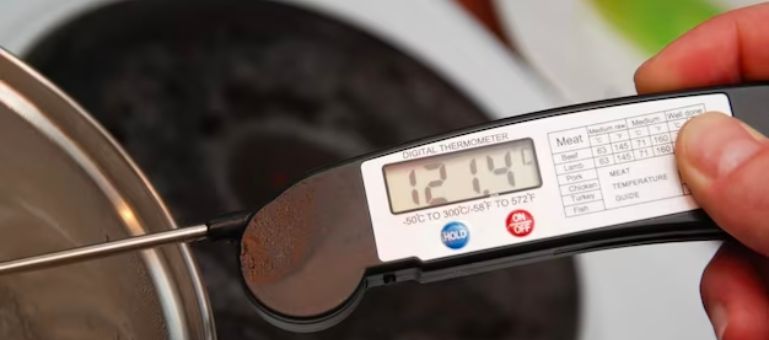Are you worried about contaminated food products jeopardizing your customers’ health and your business’s reputation?
The food industry is always at risk of contamination and spoilage, but there is a way out of this problem.
The Centers for Disease Control and Prevention (CDC) has identified which food safety practices will prevent biological hazards.
The food industry is at risk of four hazards: biological, chemical, physical, and allergenic. Each of these harms the food and beverage contents, damaging the consumers’ health.
According to the World Health Organization (WHO), approximately 600 million, with an average of 1 in 10 people globally, fall ill after eating contaminated food. The most common disease of foodborne illnesses is known as food poisoning.
This has been a concern for safety regulators and food industry owners, as contaminants that spoil food quality negatively affect a consumer’s health.
This blog will identify the top biological hazards and their impact on the food industry. Next, we will discuss the recommended guidelines and methods on how food workers should protect food from contamination after it is cooked.
What are you waiting for?
Let’s dive right into it!
Understanding Biological Hazards

What are Biological Hazards?
Biological hazards refer to microorganisms that contaminate the food when ingested.
So, how do harmful pathogens enter our bodies and cause harm?
We must understand that friendly pathogens in our body make up the normal flora and protect us against diseases. Individuals fall sick if external sources of microorganisms compromise this defense barrier, enter the body, and release by-products.
The most common sources of biological hazards include unpasteurized dairy products, contaminated water, seafood, improperly washed vegetables, and mold growing on fruits.
You must recognize the factors that influence and increase the growth of microorganisms to know how to curb them. A conducive environment for growth includes unsustainable temperatures, pH levels, and high moisture levels.
Types of Biological Hazards
The most common pathogens found in the food and water include bacteria (salmonella, E. coli, Listeria, and campylobacter), fungi (yeasts and molds), viruses (Norovirus and hepatitis A and E virus), and parasites (worms and protozoa such as giardia lamblia).
Virus
Viruses are tiny infectious agents that can contaminate food. They are a major concern due to their ability to cause foodborne illnesses. Proper hygiene and food handling practices are essential to prevent viral contamination.
Some common viruses in the food industry are mentioned below:
- Norovirus: Often associated with contaminated water and raw or undercooked shellfish.
- Hepatitis A Virus (HAV): Typically linked to raw or undercooked shellfish, contaminated water, and food handled by infected individuals.
- Rotavirus: Found in contaminated water and can be transmitted to food through poor hygiene practices.
- Astrovirus: Can be present in contaminated water, especially when sewage contamination occurs.
- Sapovirus: Similar to Norovirus, it’s associated with shellfish and contaminated water sources.
Bacteria
Bacteria are microorganisms that can multiply rapidly in food. They are a common source of foodborne diseases. Preventing bacterial contamination involves thorough cooking, refrigeration, and maintaining proper sanitation.
Some common foodborne bacteria include the following:
- Salmonella: Often found in raw meat and poultry, unpasteurized eggs, and dairy products.
- Escherichia coli (E. coli): Ground beef, raw milk, and leafy greens are common sources.
- Listeria: Commonly associated with deli meats, soft cheeses made with unpasteurized milk, and ready-to-eat foods.
- Campylobacter: Raw poultry, unpasteurized milk, and contaminated water are common sources.
- Clostridium perfringens: Often linked to improperly handled or stored cooked foods, such as stews and gravies.
- Staphylococcus aureus: Found on the skin and in the nasal passages of humans.
- Bacillus cereus: Commonly found in rice and other starchy foods.
Fungi
Fungi, including molds and yeasts, can spoil food and produce mycotoxins. These can pose health risks. To mitigate fungal hazards, storing food properly and monitoring for signs of spoilage is crucial.
Some of the most common foodborne fungi are:
- Aspergillus spp.: These molds are often found in grains, nuts, and seeds, as well as dried fruits and spices.
- Candida spp.: Commonly found in grains, dairy products, and processed meats.
- Rhizopus spp.: Often associated with the spoilage of fruits and vegetables.
- Mucor spp.: Found in a variety of foods, including fruits, bread, and dairy products.
Parasites
Foodborne parasites like protozoa and worms can infect humans when consuming contaminated food or water. Preventing parasitic infections requires rigorous food inspection, cooking, and water treatment processes.
Some foodborne parasites include:
- Trichinella spp.: Found in undercooked or raw meat, particularly pork, and game meats like bear and wild boar.
- Cryptosporidium spp.: Contaminated water sources, including untreated surface water and improperly treated swimming pools.
- Toxoplasma gondii: Often found in undercooked or raw meat, as well as in soil contaminated with infected cat feces.
Impact on Food Safety
Food and beverage that pathogens have contaminated affects the public health by large and results in illnesses.
According to a report by the WHO, approximately 420,000 die yearly, resulting in the loss of 33 million healthy life years. Of these, 125,000 deaths every year are of children under 5 years.
The direct consequence of biological hazards on food safety is the outbreak of foodborne illnesses and food poisoning. This results from improperly handling the food with hygiene, stored, or cooked, leading to cross-contamination.
The disease manifests as nausea, vomiting, diarrhea, and fever when consumers drink contaminated food and water. In severe cases, it can lead to hospitalization or death. These outbreaks can affect many people, including pregnant and the elderly.
Food safety incidents result in public health investigations and recalls of contaminated products from retailers. This damages the reputation of businesses in the food industry. Consequently, the brand can lose the consumer’s trust and confidence.
Such businesses associated with foodborne illness outbreaks experience a loss in customer loyalty and significant financial losses from decreased sales.
Unsurprisingly, food companies that fail to abide by food safety regulations and sell contaminated products face legal consequences. This can easily change consumer trends as they avoid certain foods.
Preventive Practices for Biological Hazards

The solution to prevent people from falling sick consistently is taking precautionary measures that mitigate disease transmission and its long-term health risks.
The Hazard Analysis and Critical Control Point (HACCP) system directs and guides proper food handling.
The HACCP principle in the food and beverage industry is based on hazard analysis, critical control point identification, establishment of critical limits, monitoring procedures, corrective actions, record keeping, and verification procedures.
Ensure your food business is functioning in compliance with the regulations. Let’s look at preventative practices for biological hazards.
Proper Handwashing

The first and essential step in preventing biological hazards is frequently handwashing before handling fresh produce. For this purpose, the food owners should invest in hand washing stations with proper hand drying throughout the manufacturing unit.
As simple as it may sound, handwashing with soap and warm water removes dirt and microorganisms from the skin and prevents foodborne illness. This has proven effective in improving overall food safety in home and commercial kitchen settings.
This requires workers to adhere to sanitation guidelines to ensure clean hands for safety. It is recommended that alcohol-based sanitizer should not be used as a replacement for handwash, as it does not eliminate pathogens such as Norovirus.
Safe Food Handling and Storage
The World Health Organization has laid out golden rules that all food business owners must abide by for safe food handling. We will review each in detail to prevent biological hazards in food handling.
- Choose safely processed food: When receiving fresh produce such as fruits, vegetables, and milk, ensure it has passed the necessary safety handling guidelines.
- Separate Raw and Cooked Foods: Keep raw meats, poultry, and seafood separate from ready-to-eat foods and use separate cutting boards and utensils to prevent cross-contamination.
- Temperature Control: At times, cooking temperatures are not well regulated. This can lead to disease-causing organisms in processed foods, such as raw eggs and unpasteurized milk. Thoroughly cooking the food at a minimum temperature of 70°C is essential. The same rules apply to storing cooked foods at the recommended temperatures. Cooked food should be cooled to 10 °C or below or kept hot above 60°C and then stored for a minimum of five hours. This ensures that microorganisms do not thrive in a warm environment. If you need to thaw frozen foods, use the refrigerator, run it under cold running water, or in the microwave. Avoid thawing at room temperature, as it allows bacteria to multiply rapidly.
- Sanitize the kitchen surfaces: Use commercially available chlorine or bleach cleaners and wipe surfaces and floors repeatedly. This also calls for doorway sanitation to control possible contamination from footwear in a food facility. It requires controlling microorganism entry using sanitary mats and shoe covers and ensuring workers change into designated work boots.
- Labeling products: Menu labeling allows for first-in, first-out to be practiced as it is essential to use the food products in the shelf life.
Cooking to the Right Temperature

Did you know that proper cooking temperatures kill harmful microorganisms such as parasites, fungi, and bacteria in food items?
Food handlers must follow the standard operating procedures on cooking temperatures and methods for food safety. The United States Department of Agriculture Food Safety and Inspection Service has set the safe minimum internal temperature for all food products.
But before you start cooking, follow the protocols of safe food handling. These are washing the hands and surfaces and separating raw and cooked products.
Let’s get cooking.
It is directed that while cooking food items, the temperatures should be measured and recorded using food-grade thermometers before removing the heat source.
This is because the food color or cooking time is not a reliable indicator of pathogens being destroyed.
However, keep in mind that there is a temperature danger zone. This range exponentially accelerates microorganism growth. This means food products between 70 °F and 125 °F are prone to bacterial growth.
Food items that require time and temperature control safety include the following:
- Dairy products, including milk
- Meat and poultry
- Seafood (fish and shellfish)
- Shell eggs
- Baked potatoes
- Cooked rice, beans, and vegetables
- Oil mixtures
Here are some ideal minimum internal cooking temperature recommendations from the guidelines.
Food items may have rest time, which allows the internal temperature of the meat to stabilize and ensures that it is safe to eat.
Monitoring and Inspection
Regular Inspection of Food Establishments
Regular check-ins and inspections are the only way to ensure that industrial kitchens and food manufacturers adhere to safe food handling guidelines.
The state food authority conducts bi-monthly or quarterly inspections of the food warehouse and manufacturing site to work with the owners and identify any guidelines violations.
A food establishment could be violating regulations related to refrigeration, proper cooking temperatures, the area’s sanitation, and the workers’ hygiene. If a company is found guilty of contributing to biological hazards, it can be met with fines or closing down.
To prevent this, food industries should have employees repeatedly oversee and monitor the company’s biological hazards. These quality control checks are essential in preventing foodborne illnesses early and from spreading and spoiling food.
Keep reminding your employees that regularly inspecting and cleaning the utensils creates a safe food-handling environment.
Microbiological Testing and Analysis

If the food product has been labeled unsafe for consumption, what is the ideal way to detect pathogens?
Microbiological testing detects the pathogenic bacteria, viruses, parasites, and molds contaminating the food. Identifying the harmful pathogen is as necessary as preventing it, as this can help you take the proper steps.
This falls under food microbiology, which conducts quantitative and qualitative tests to find the source of an illness outbreak. In such cases, it helps identify the product batches and trace and recall the lot from retailers.
Microbial analysis is reliable as it includes hygiene monitoring for microbiological analysis of air, surfaces, and personnel. It also tests for water, pathogens, indicator organisms testing, and spoilage organism testing.
The HACCP guidelines recommend microbial testing to assess the quality of food products, as spoilage can lead to off-flavors and textural changes.
This means that the industry owners should ensure that each batch has undergone microbial testing and meets the safety standards before being distributed.
Making microbial testing a standard operating procedure for your products dramatically improves the consumer’s confidence. Customers will purchase products that have undergone rigorous testing and are safe to consume.
Conclusion
We cannot deny that food and beverages are excellent breeding grounds for harmful biological hazards, such as bacteria, viruses, and fungi.
In this blog, we discussed the common foodborne pathogens, their impact, and which food safety practices will help prevent biological hazards.
While many factors influence the food’s quality, microorganisms can cause spoilage and lead to food poisoning in the population.
The risk of biological hazards to the food industry is immense, resulting in recalled product batches and consumers losing trust in the brand.
The ideal solution to such biological hazards includes implementing regulations and following guidelines by the food authorities.
A pivotal practice to food safety is ensuring workers follow proper washing techniques and schedules throughout the facility and sanitize the surfaces.
To keep the food safe for consumption, it should be cooked at a minimum internal cooking temperature to kill the pathogens. After cooking, it has to be stored in a regulated freezer and refrigerator to slow down microorganism growth.
Lastly, standard operating procedures in the food industry include consistent microbial testing and analyzing each batch to identify foodborne illness outbreaks.
Do you invest in a safer and healthier future for your consumers with proper food handling?
What are you waiting for?
Nurture a safe environment and protect food from contamination!













